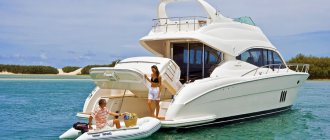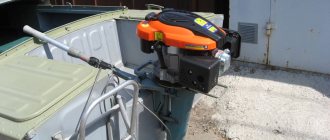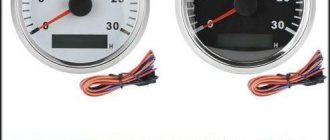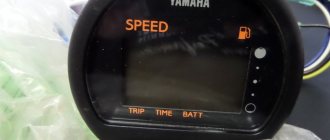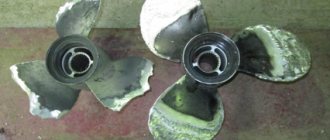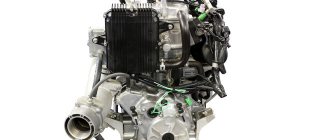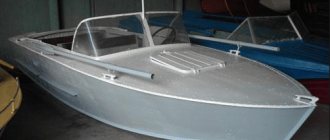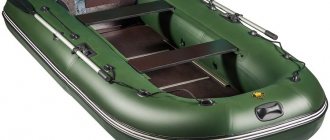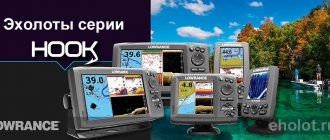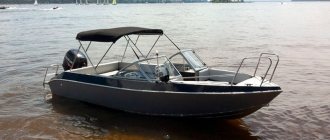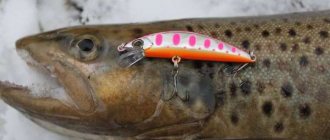Description
The last global modernization of the outboard motor took place in 1993. Veterok 12E from 1987 was chosen as the basis. The updated model received a number of fundamental changes that remained until the production of the engine was completed.
- Magneto MBE-3 of increased reliability with improved cooling of thyristors;
- anti-cavitation plate of a new form;
- higher compression ratio (7);
- fuel tank increased to 20 liters;
- needle bearing instead of a bronze-graphite bushing;
- propeller hub of higher reliability;
- improved tiller design;
- two propellers (cargo and high-speed).
At the same time, the domestic engine never became the standard of reliability. The loads on the device bushings significantly exceeded the critical ones. And if the 8-horsepower Veteroks worked for decades, their more powerful “brothers” regularly broke down. The average service life of the Veterok 12 motor was 2-3 years, after which the engine began to break down. The only solution to this problem was careful operation. Without full throttle, no heavy loads were created, and breakdowns occurred less frequently.
From a technical point of view, Veterok 12 was very far from perfect. The outdated technologies used in its production did not allow it to compete with foreign analogues in terms of efficiency and productivity. That is why the 12-horsepower modification was soon replaced by a 14-horsepower engine with an improved design.
Over the years of production, the engine has been modernized several times. Among the most famous versions of the motor are:
- Veterok 12E – the first global modernization (1978);
- Breeze 12R. Version released in 1995. This motor received a reverse gearbox, but was released in a limited edition due to low demand.
- Veterok 12U, Veterok 12RU. A model with a reinforced gearbox and an extended sternwood, designed for more massive yachts and boats.
Advantages of the Veterok 12 model:
- excellent maintainability. A domestic product can be repaired in a home workshop without special skills;
- relatively low weight;
- high propeller efficiency and low underwater drag;
- easy start;
- low cost of the motor (almost two times less than foreign analogues) and spare parts for it;
- high reliability;
- unpretentiousness and the ability to work with low-quality gasoline;
- high quality processing and painting;
- Beautiful design.
- lack of reverse gear in most modifications;
- outdated parts;
- inconvenient propeller mounting;
- loud noise during operation;
- lack of a thermostat, without which it becomes extremely difficult to maintain normal thermal conditions;
- extremely unstable operation at the initial stage of movement;
- Great effort when starting manually.
Maintenance
Like any complex technical unit, a boat motor requires regular preventive inspection and correction of “suspicious” systems and elements. In particular, it is necessary to periodically inspect the spark plug electrodes, the tightening of screws, bolts and nuts, check the quality of fixation of the control panel to the suspension, etc. The ignition of the Veterok outboard motor is a rather complex system in terms of maintenance, since identifying faults requires the use of an ohmmeter. Using this device, you can detect shorted winding terminals, problems with a thyristor, capacitors or diodes. Well, the presence of oil must be checked. A high-quality composition will extend the operating life of the motor, so a systematic check after 25 hours of operation should become the norm.
Engine
Parameters of the two-stroke outboard motor Veterok 12:
- working volume – 0.249 l;
- rated power - 12 hp;
- rotation speed – 5000 rpm;
- number of cylinders – 2;
- cylinder diameter – 60 mm.
The weight of the unit is 26.5 kg.
The engine is unpretentious even during the running-in process, which can be done in an ordinary barrel. During break-in, a fuel mixture containing gasoline and oil in a ratio of 25:1 is used.
The process itself consists of 4 phases:
- starting and running at low speed for 20 minutes;
- work at medium speed for half an hour;
- operation at 3000-3500 rpm for 1-1.5 hours;
- work at maximum for 4 hours.
General information about the motor
In accordance with the manufacturer's recommendations, the Veterok 8M motor can be used on boats whose transom height reaches 38 cm. In this case, the depth of the reservoir must be at least 50 cm. The engine is equipped with an electronic non-contact ignition system, and also has the ability to connect devices that power signal lights. To perform the launch, the Veterok 8M outboard motor is equipped with a starting mechanism, supplemented by a retractable cord. Due to the low placement of this device at the time of start-up, the tilting force of the unit is reduced.
Cooling of the Veterok power plant is carried out using a special pump that draws water from the reservoir. The user controls and controls the motor using the tiller. For comfortable use, the unit is equipped with a holder for the tilted position, an idle clutch and a spring-type suspension, which eliminates vibration transmission to the boat.
Reviews
Despite all the imperfections of the Veterok 12 outboard motor, reviews about it are mostly positive.
Oleg purchased the engine in 2011. At that time, the age of the unit was 30 years. The old model was tested on the Iset River. Together with a friend, we installed a motor on a PVC boat of the Liman 320 model weighing 52 kg. The first time Veterok 12 did not want to start. However, starting from the top starter was successful. The engine rattled loudly, but after installing a special cover the sound died down somewhat. At idle, the unit held its speed confidently, but at speed it was necessary to add gas so that the engine did not stall.
The engine handled the glider with two passengers weighing 190 kg very confidently. I especially liked the movement on the high-speed propeller. Sometimes it was possible to go on the glider even with three passengers. However, in this case it was necessary to use a cargo screw.
Motor operating principle
The Veterok power unit performs the drive function in a 2-stroke cycle, in which the crank-chamber deflector purge also participates. During operation, suction, compression, power stroke and exhaust are performed - this cycle is performed in two piston strokes, which also corresponds to one revolution of the crankshaft.
In the crankcase cavity, when the piston moves upward, a vacuum is formed, as a result of which the working mixture escapes into the free cavity from the carburetor - this happens when the intake valve opens. At the moment of the lower movement of the piston, the valve automatically closes, and the mixture in the crankcase is compressed. When the exhaust and purge windows, which are also equipped with the Veterok outboard motor, are opened, the working mixture from the crankcase rushes into the cylinder. In this way, the cylinder cavities are purged and further filled with a new mixture.
Technical characteristics and design of Veterok motors
Outboard motors of the Veterok family are designed for installation on boats for utility, pleasure, tourism and sports purposes. They are successfully used on motor and propeller boats, such as “Kazanka”, “Yuzhanka”, “Trout”, (“Mullet”), “Taimen”, “Yaz”, “Avtobot”, “Kazanka-6”, “Romantika- 2”, “Tavria”, on inflatable rubber boats “Orion-8”, etc. These motors are widely used on wooden displacement boats, on a variety of small self-built vessels, and as a backup engine for yachts.
“Veterok” motors are designed for installation on boats with a transom height of up to 380 mm (models with an extended deadwood “Veterok-8U” and “Veterok-12U” are designed for a transom height of up to 500 mm) and can be used in any reservoir with a depth of at least 500 mm . “Veterok-12” is used on sports motorboats in the class of engines with a displacement of 250 cm3. “Veterok-8” (“Veterok-8E”) and “Veterok-12” (“Veterok-12E”) are largely unified (Fig. 1). Motors with the index “E” differ from the original models only in the configuration of an electronic contactless ignition system.
Technical characteristics of Veterok motors
Two-stroke carburetor gasoline
Clockwise
From flywheel Magdino MBE-3 with remote transformers 2112
Automotive transmission oil TAp-15V (GOST 23652-79) or other automotive summer transmission oils
| “Veterok-8E” “Veterok-12E” Engine type | |
| engine's type | |
| Rated power at 4800 rpm, kW (hp) | |
| Number of cylinders | |
| Cylinder displacement1, cm3 | |
| Cylinder diameter, mm…. | |
| Piston stroke 2, mm | |
| Effective compression ratio3 | |
| Flywheel rotation direction when viewed from above | |
| Mooring thrust, not less than N | |
| Ignition system | |
| Spark plug | AP (GOST 2043-74) |
| Voltage, V/power, W, lighting systems | |
| Gap between electrodes in spark plug, mm | |
| Carburetor | |
| Fuel and oil | Automotive gasoline A-76 (GOST 2084-77) with the addition of M-8B1 oil (GOST 10541-78) |
| Hourly fuel consumption, kg/h no more | |
| Valve timing, degrees: | |
| release | |
| purging | |
| Gear ratio | |
| Gearbox lubrication | |
| Propeller diameter, mm | |
| Propeller pitch, mm | |
| Number of blades | |
| Fuel tank capacity, l | |
| Motor weight, kg | |
| Overall dimensions of the motor (with the tiller raised up), mm: | |
| 350 | |
| length | 500 |
Veterok motors consist of the following main components and systems:
motor head with upper and lower casings (engine assembly with magdino, high-voltage transformers, starting mechanism, carburetor, fuel pump, carburetor control parts and ignition timing);
intermediate gear with suspension (intermediate housing with idle clutch switching mechanism, control plate with tiller, suspension with parts for attaching to the boat transom, turning and tilting the motor);
underwater part (gearbox with gear and propeller shaft, spacer with idle clutch, water pump, propeller);
engine power systems (gas tank, gasoline hose with manual pumping bulb, carburetor and diaphragm fuel pump);
ignition systems (magdino, high-voltage transformers, spark plugs);
cooling systems (suction pipe, water pump, pressure pipe, engine cooling jacket). A longitudinal section of the motor is shown in Fig. 2.
Rice. 2. Longitudinal section of the motor. 1 – crankcase; 2 – partition with valves; 3 – pipe; 4 – carburetor; 5, 69 – ball bearings No. 204; 6 – needle roller; 7 – crankcase cover; 8 – locking cam; 9 – base of Magdino; 10 – crankshaft key; 11 – flywheel; 12 – cylinder block; 13 – crankshaft; 14 – connecting rod; 15 – piston pin; 16 – piston; 17 – piston ring; 18 – piston pin retaining ring; 19 – candle; 20 – cylinder head; 21 – intermediate body; 22 – lever; 23 – vertical shaft; 24 – thrust; 25 – plate; 26 – clamp; 27 – pump body; 28 – impeller key; 29 – impeller; 30 – bottom plate; 31 – oil seal; 32 – ball bearing No. 201; 33 – glass; 34 – tube; 35 – drive coupling; 36 – fork; 37 – driven clutch; 38 – water intake; 39 – screw damper; 40 – pin; 41 – cap; 42 – propeller; 43, 68 – oil seals; 44 – retaining ring; 45 – stuffing box; 46 – sealing ring; 47 – ball bearing No. 205; 48 – adjusting washer; 49 – driven gear; 50 – ball bearing No. 201; 51 – horizontal shaft; 52 – drive gear; 53 – gear housing; 54 – roller bearing No. 7203; 55 – ball bearing No. 203; 56 – spacer; 57 – lower spring; 58 – lock; 59 – lower liner; 60 – outer bearing; 61 – suspension bracket; 62 – emphasis; 63 – suspension support; 64 – upper liner; 65 – pipe; 66 – support screw; 67 – pad; 70 – upper spring; 71 – control plate Fig. 3. External characteristics of engines
The external characteristics of the Veterok engines - the dependence of power and specific fuel consumption on the crankshaft speed with the carburetor throttle fully open - are shown in the graph (Fig. 3).
Trouble-shooting
In motorboats, the propulsion system is the main source of technical problems. Its failure can be caused by various reasons, including lack of fuel or incorrect adjustment of the carburetor, too much fuel, damage to the valves, etc. Some of these problems can be eliminated by purchasing a new spare part for the Veterok outboard motor - the need for an update may affect the valve in the crankcase , impeller with key, gaskets, dampers and other elements. But it happens that restoration of performance can be achieved by simply adjusting the same carburetor, suspension, shift clutch, or by introducing new devices into the design, such as an intermediate frame for a deeper seating of the engine.
Boat motor Veterok 12
Veterok-12 is a small-displacement boat engine developed in the USSR. The engine was considered advanced for its time and had specific technical advantages compared to foreign analogues. But at the same time, Soviet engineers did not hide the fact that this model borrowed many elements from famous foreign engines. Many business executives and fishermen perceived this fact as an undeniable advantage in the budget price category, and as a result, Veterok-12 gained worldwide popularity. The engine was especially in demand in the USSR, since the models of the Veterok family had no equal in the Soviet Union. To create an innovative design solution in the absence of competition is a brilliant idea of the parent Ulyanovsk small engine plant. Despite its considerable age, the motor is still in demand. There are quite a lot of such motors on the used market, and almost all of them are in good condition. Let's consider the main features of the Veterok-12 model, its characteristics, as well as reviews from owners about this engine.
Spare parts for the motor
The manufacturer has provided for the repair kit the entire list of spare parts, as well as components and assemblies that are equipped with the Veterok 8 outboard motor. Parts available for home repairs include gaskets, valves, seals, piston rings, springs, pins and other items.
For a more thorough repair, you may need a pipe, crankshaft, crankcase cover, middle support, cylinder head, etc. In addition, there are special sets of tools that are used to repair the engine. These are wrenches and socket wrenches, flywheel pullers, screwdrivers and wrenches. Owners should also look for fuel tanks, hoses, and a crank starting cord as additional accessories.
General information and design
Veterok-12 has a classic time-tested two-stroke design. The two-cylinder layout had a beneficial effect on fuel consumption, maintainability and ease of maintenance at home. Moreover, owners of this engine can save a lot on fuel, because the Veterok-12 model supports fuel with a fairly low octane rating, starting with A-66 and A-72. Thus, the now in demand AI-92 can be filled into this engine without fear.
The two-stroke engine received deflector purging of the cylinders. The ML-10-2S device serves as the ignition system. The recommended spark plug is type A7 or 5Us. The gearbox must be lubricated with automotive transmission oil. The motor turned out to be compact and not too heavy. This feature allows you to place it in the trunk of a car. There will also be no problems when installing the motor - one person can handle this without resorting to outside help.
Veterok-12 has a working volume of 250 cubic meters, which allows it to be installed not only on small-sized, but also medium-sized vessels, including inflatable boats and motorboats. Thanks to this, the engine is suitable for commercial structures and will be in demand in the professional field, in fishing and hunting activities. The possibilities of the motor are unlimited, because it can be used to move not only along rivers and lakes, but also in salty sea waters. This is facilitated by a high level of protection for the underwater part of the motor housing. The protection protects the engine from underwater obstacles, rocks and other obstacles. Thus, Veterok-12 has proven its relevance not only on long trips, but also when moving in shallow water.
Please note that Veterok-12 has many interchangeable parts that fit from the Veterok-8 motor. This fact significantly increases the maintainability and ease of maintenance of the motor. The endurance and durability of the Veterok-12 motor is confirmed not only by an effective cooling system and high-quality assembly, but also by 500-hour operational tests on a special stand. Then the engine successfully passed real tests along the route Ulyanovsk - Cheboksary - Ulyanovsk, moving along the Volga River.
Ignition system
Electronic non-contact ignition is one of the main features that distinguishes the Veterok 8 outboard motor. The characteristics and composition of this device look like this:
- thyristor – KU202M series;
- diodes – KD209A series;
- capacitor – charge 400 W;
- resistor - resistance 0.5 Ohm;
- spark plug – element A11-3;
- transformer;
- control and storage windings of the ignition coil;
- winding for lighting coil;
- incandescent lamp.
In general, the electronic ignition of the Veterok outboard motor includes a flywheel magdino, two remote transformer systems and two spark plugs. The flywheel, in turn, is equipped with four pole shoes and three permanent magnets. Four cables come out of the Magdino base: to ground, to the lighting system, and two are connected to the cylinder transformers (upper and lower).
Run-in
Veterok-12 is a supported engine in demand on the secondary market. Its first owners, according to the manufacturer's recommendations, had to undergo timely maintenance and run-in. However, this applies to every owner of a boat motor. Even if the engine is maintained and the running-in has already been carried out, nothing should prevent it from being carried out again. Moreover, in our case this is doubly necessary. After all, at the same time, the owner will be able to evaluate the potential of a used motor and reveal its potential in the most severe conditions. It is logical that the owner should initially know the capabilities of the engine, and also understand what it is capable of when maintained. It is possible that some defects will be identified during the running-in process, but the driver will know about them in advance and will be able to eliminate them so that these defects do not develop into larger problems in the future.
The running-in period is only 10 hours. In this regard, for this procedure it is necessary to select a suitable reservoir in which it would be possible to reveal all the capabilities of the motor without fear of its overheating and the appearance of various defects. We can say that during the testing period the engine must be fully run-in, and for these purposes a river, lake, stakes, sea or other body of water is ideal - the main thing is that its depth is at least 80 cm.
All moving parts of the motor must function as expected, and the motor must be installed in a vertical position before adding consumables. The fuel mixture is prepared in advance by mixing gasoline and oil in a ratio of 50:1. The engine oil must be TCW-3 type. Having prepared all the necessary materials and selected a reservoir for running in, you can begin the procedure.
- Start the engine and let it warm up at idle speed.
- We start driving at low speeds
- Let us pay attention to how the increase in speed should occur: ideally, a gradual increase is welcomed, for example by 5-10 percent every hour. Thus, after about 8 hours, the motor performance will reach 80-90 percent. An increase to 100% is possible, but in this mode you need to closely monitor the operation of the cooling system. The fact is that after 20-30 minutes the system may fail, which can cause overheating
- You can avoid overheating and thermal shock at 100 percent load by reducing the speed to the lowest zone. At the same time, a variable load and all engine speeds will be involved, and this is very useful for adapting all components of the power plant
- After 10 hours of running-in, the engine must be cooled and turned off, then a technical inspection and replacement of consumables must be performed.
Starting system
Activation of the Veterok power unit is carried out through a manual mechanism, which also has a self-retracting cord. At the moment the cord is pulled out by the handle, the pulley begins to rotate in two bearings, and the gear, due to the brake spring and screw slots, engages with the flywheel - engagement with the ring gear occurs. Next, the crankshaft is turned and the Veterok outboard motor starts. In this case, the gear and flywheel diverge.
When the cord handle is released, the spring causes the pulley to rotate in the opposite direction. If malfunctions in the mechanism are detected during operation, the engagement of the flywheel and gear may need to be adjusted. This is done by installing a pin into the pulley, that is, into one of its holes.
Reviews about the motor
The Veterkov family has existed for several decades, and to this day its representatives are in demand on the boat equipment market. The first hours of engine operation can be disappointing with low power. More precisely, the declared 8 “horses” are not going anywhere, but experienced users note the insufficient traction that the Veterok outboard motor has. Reviews also note frequent breakdowns, blockages, as well as an uncomfortable fit, due to which preventive examinations become mandatory almost after every use.
But there are also advantages, thanks to which the domestic engine has retained its popularity, and not only in Russia. First of all, it is distinguished by its maintainability. This means that you can not only repair the engine, but do it yourself from a standard set of publicly available spare parts. That is, breakdowns are frequent, but they can be easily fixed, while foreign four-stroke competitors, although they break down less often, cause much more problems with subsequent repairs. Otherwise, “Veterok” shows decent results both at full speed and in trolling. For example, the opinions of fishermen about it are mostly positive - among medium-power outboard motor engines it is not easy to find a high-quality and inexpensive copy, and “Veterok” largely justifies itself, despite all the disadvantages.
